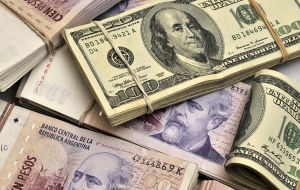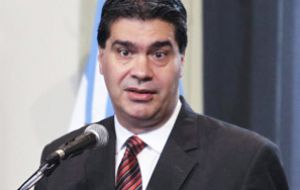MercoPress. South Atlantic News Agency
Argentine foreign money market operating at 8.015 Pesos to the US dollar
 Many Argentines managed to overcome the bureaucratic steps but have been unable to get hold of the dollars
Many Argentines managed to overcome the bureaucratic steps but have been unable to get hold of the dollars For second day running the Argentine foreign money market reacted with normality with the official rate of the US dollar closing at 8.015 Pesos, while the so called 'reference dollar' for savings traded at 9.62 Pesos and the 'blue' or parallel climbed 35 cents to 12.50 Pesos.
So far this year the Argentine Peso has depreciated 23%, which compares with the 23% of the eleven and a half months of 2013, which finally ended down 32%, which gives an idea of the volatility of the market in recent weeks.
On Monday the government of President Cristina Fernández implemented the new system by which Argentines can purchase dollars for savings, (which had been effectively banned two years ago), but they must have a minimum monthly income of 7.200 Pesos (900 dollars) and there is a 20% maximum on salaries and an overall 2.000 dollar cap.
The dollars are authorized by AFIP, the tax office which checks everybody is spic and span, and delivered in a check that must be deposited in a bank for at least 365 days, if not the there will be an extra 20% charge.
According to AFIP data on Monday there were 149,606 applications by Argentines seeking to purchase dollars totaling over 60 million dollars. The figures were exposed by Cabinet Chief Jorge Capitanich who explained 242 operations have been registered accounting for 122,273 dollars.
Capitanich added that the system controlled by AFIP to allow the purchase of greenbacks is working “efficiently,” urging banks to adjust their systems “rapidly” in order to allow a smooth operations flow.
In his daily brief to the press at the Government House, Capitanich called for “trust” in Argentina’s economic policy saying that problems come when “saving and investments” don’t walk hand in hand.
“Saving in any of its ways, from dollars to goods, is a result of consumption surplus,” he insisted and rejected what he called the “lies” by some media groups that “have nothing to do with reality” when there is “concrete data tied to the country’s macroeconomic sustainability.”
AFIP later in the day explained that an estimated 75.000 applications were not validated for different reasons, and confirmed the data provided by Government House earlier. Most requests were below the 7.200 Pesos minimum and another significant percentage had previous requests approved but never complied.
Finally the so called 'blue' dollar operations were minimum and only those in real need were prepared to pay 12.50 Pesos. Apparently traders will only sell the dollars at a high price until the system is fully implemented and all banks are operating with it. So far only money exchange houses have adapted to the new mechanism.





Top Comments
Disclaimer & comment rules-

-

-

Read all commentsStevie
Jan 29th, 2014 - 07:10 am 0Think
Paul Cee-ment
Axel Arg
How can this be?
The ARS Peso is still spiraling down.
Axel, how does this affect your insistence that, “ the Argentine economy grew by 5%”?
Troy Tempest.
Jan 29th, 2014 - 07:33 am 0Last year the Canadian was at parity with the USA $.
It's down 12% now from that.
http://online.wsj.com/article/BT-CO-20140128-712820.html
The Australian is down 15%.
After losing over half its value, the once-mighty US dollar was bound for a secular rebound... but make no mistake, it will eventually resume a downward spiral.
@2
Jan 29th, 2014 - 08:23 am 0So, you have a billionaire and millionaires having a peeing competition...
Lets get back to the third world story here: the Argenzuala Peso continues its descent into toilet paper.
Commenting for this story is now closed.
If you have a Facebook account, become a fan and comment on our Facebook Page!